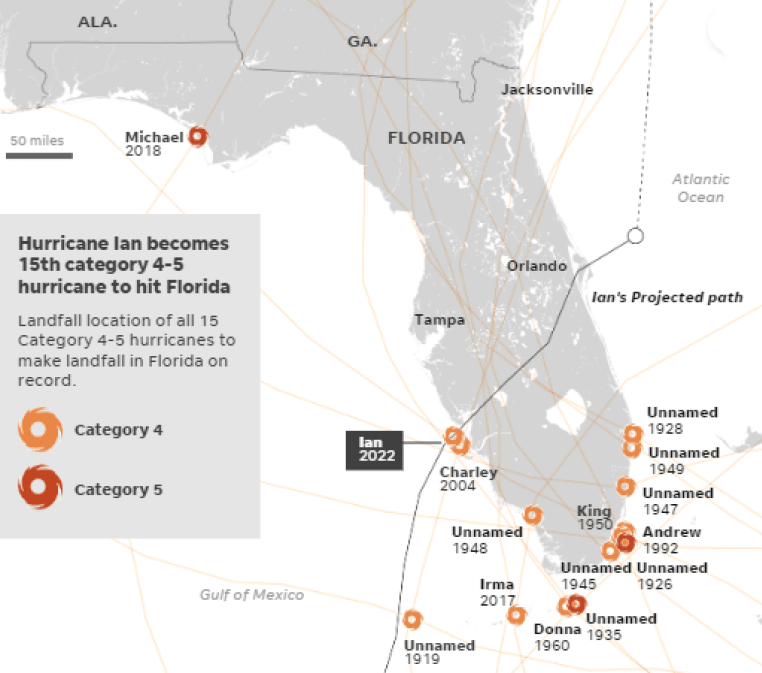Hurricanes and Housing Values | Craig Cerreta, Managing Broker, Premier Sotheby’s International Realty
(October 10, 2022)
Though no two natural disasters are the same, there are real estate pat-terns which can be identified and anticipated following a natural disaster. It doesn't matter whether it's a hurricane, an earthquake or a massive fire. Many patterns repeat themselves year after year, disaster after disaster.
KEY FACTORS TO CONSIDER:
Extent of damage
Location relative to the primary impact zone (Major damage zone)
Risk of increased frequency and intensity
Insurance
New Construction
Supply and Demand
EXTENT OF DAMAGE
The question is not whether a hurricane is a Category 3 or Category 5, it is how much damage did it cause. There is a huge difference between a storm that downed trees versus one that destroyed neighborhoods. News and social media provide images of the worst damage with little clarification as to the geographic scope. Public perception is almost always one of maximum destruction in a much broader geographic area than actuality. This incorrect perception stimulates emotions that can cause some owners to panic sell and some buyers to delay or cancel plans to purchase.
LOCATION RELATIVE TO THE IMPACT ZONE
The impact on people and housing values is far different for homes in the primary impact zone versus those in the sur-rounding areas. Most disasters experience a concentrated area of major destruction that may range from a few blocks to few miles wide. People within that concentrated area are far more affected than people on the fringes even though the people on the fringes also have damage. Within the primary impact zone, families experience significant material loss and possibly physical injury. As a result, their reaction to the disaster is more extreme than the reaction of those in nearby areas. Some of these people may experience Post Traumatic Stress Disorder (PTSD). A number of people within the primary impact zone are likely to leave the area and not return or rebuild. It is just too emotional and psychologically draining for them to remain in this area. A “Realtor.com” study estimates this number at 34% of the victims within the primary disaster zone.
Short term the value of homes and land within the primary impact zone are likely to drop because people cannot live there, insurance settlements will take weeks if not months, and rebuilding may take years. Long-term the primary impact zone should recover and exceed prior values as new development replaces the old product making it even more desirable. Just beyond the primary impact zone, the number of people who leave and do not return is minimal even though they may have damage. To the outside public, these “fringe” areas are thought to be major disaster areas because that is what they see on TV and Social Media, but actual damage is sporadic in fringe areas.
Ian caused a flood surge in Naples that resulted in significant damage on the waterfront, yet just beyond the waterfront (literally a couple hundred yards), there is no wind damage or water damage. Restaurants are open. Life is normal. Waterfront homes will have a short term value impact, but beyond that no impact at all. The same holds true for areas like Punta Gorda, Port Charlotte, Englewood, Venice and more. Yes there are trees down, shingles lost and other damage, but life was back to near normal within days. Residents in these fringe areas (just beyond the primary impact zone), but still within the areas damaged, typically repair or rebuild as quickly as possible. The value impact will be on a house by house basis, not an entire area.
INSURANCE
Hurricane Ian is likely to result in an industry loss of $50+billion. This puts a major strain on the state’s insurers and increases the odds that more insurance carriers will leave the state over the coming years. The state's homeowners already pay the highest average annual homeowners insurance premium at a cost of $4,231, compared with the nationwide average of $1,544. Private insurers in the state have lost more than $1 billion for two straight years (AP Report). Six local insurers have declared insolvency so far in 2022 and another 27 are on a state watchlist. Ian is set to further pressure premiums, which were already up 20% to 33% in Florida in 2022, compared with 2021. Though no one knows the ultimate impact, the expectation is that major claims combined with fewer carriers will result in substantial increases over the next couple of years. Some estimates place it around a 30% increase with as much as 40% to 50% percent in the highest risk areas. Wind damage is what people see on TV, but it is the storm surge that causes the greatest risk of life. Though the west coast of Florida historically is not any riskier than other coastal areas as far as wind, it is more at risk for storm surge due to the shallow waters less than 30 feet deep for over 30 miles beyond the coast. Shallow waters mean less water capacity when a storm pushes water towards the shore. This fact has a direct correlation to increasing insurance claims.
Insurance costs indirectly affect home values due to total combined cost of ownership. Increasing insurance rates could actually have a greater impact on the value of homes than fear of storms. At some point a large segment of the population simply cannot or will not pay higher rates. The ultra luxury home segment is less impacted by increases than the average American segments, further exasperating the affordability gap in many parts of Florida.
NEW CONSTRUCTION
Natural disasters nearly always result in a building boom for the area most impacted. Southwest Florida is going to rebuild. Sanibel Island, Ft Myers Beach, and many more will see non-stop construction for the next several years. As a result the construction supply chain throughout the southeastern US will be impacted as construction materials are redirected to the areas most affected. Labor will also shift resources to these same areas as a combination of FEMA funds and private money flows into the area potentially paying a premium to lure the labor force to the area.
The homes and condos that are rebuilt in the primary impact zone will be newer, safer and better than what was lost. New construction quality and safety codes make a huge difference in a structure’s ability to with-stand storms, but it comes at a cost. It simply costs more to rebuild a new home at today’s code than the older home that is being replaced. Those costs are passed along to the insurance companies and potential new buyers for the area.
Will the most Damaged Areas see Increased Long-Term Values? YES
There is no question that the primary impact areas that are rebuilt experience increased value over the coming years as a direct result of new construction rebuilding. There is also no question that these are areas of high demand. Many previous owners will remain but even more new comers will purchase.
Do Surrounding Areas benefit from New Construction too? YES
What about surrounding areas that require repair but were not completely rebuilt? The shortage of construction materials and labor drive up cost in these secondary areas too. The correlation to increase value is less direct, but they should still see increased prices over the coming years as the entire region sees a benefit from improved construction codes and quality of construction.
Areas like Sarasota, just beyond the damage area, should also see a price lift. First, demand will shift to areas that have inventory to purchase today. In addition, new construction in Sarasota will cost more tomorrow than today for the same reasons. Builders will pass the increased costs along to buyers. It won’t be as direct as in are-as of greater damage, but it will be realized.
Will older homes not affected by the storm or construction see a value benefit? Yes but to a lesser degree and with inconsistency depending on the age of the home and the existence of updates such as hurricane grade windows and roofs. Older homes ride the coattails of new construction value increases but only when they keep up with available improvements that make them safer and more appealing.
How will home values adjusted POST-Ian? TBD
The answer will play out very differently depending on distance from the primary impact zone and the extent of destruction. Odds are good that Sanibel Island, which lost its only access (causeway / bridge) and experienced massive destruction, will take 4 plus years to rebuild and recover. Ft Myers Beach (which has access) will most likely take 2 to 4 years to rebuild. Ft Myers proper and Cape Coral will begin repairing and rebuilding immediately with homes and businesses coming back anywhere from 6 months to 2 years depending on the individual level of damage for a given home or condo. Fringe areas beyond are already back to normal overall, with individual homes experiencing repair or rebuild.
During these repair and rebuilding times, nearly all areas that experienced significant flooding or wind dam-age will see a nearly non-existent public real estate market. Fewer homes will come to market. Some will sell off market and some areas will see substantial investment by larger developers or hedge funds. But few homes will be listed and marketed in a traditional manner until the immediate area sees recovery progress. There will be some investment opportunities but they will be harder to uncover than the average individual investor thinks. As with most things in life the big boy money will capitalize the most, because developers will rethink the best use of land and make investments that will ultimately result in a higher value down the road.

